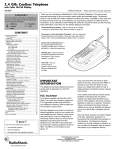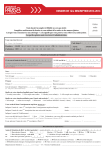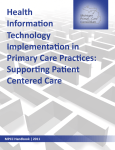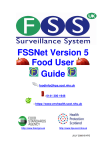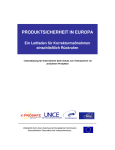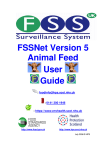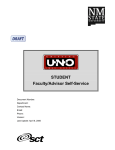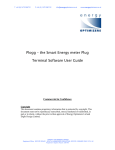Download Worcester City ENVIRONMENTAL HEALTH SERVICE MANUAL
Transcript
Worcester City ENVIRONMENTAL HEALTH SERVICE MANUAL Section A2 Council Item 5 FOOD SAFETY ENFORCEMENT AND PROSECUTION POLICY Issue Issued By M.N. Gillies Page 1 Date 01 January 2003 Authorised By R.G.Fidoe Of 9 CITY OF WORCESTER FOOD SAFETY ENFORCEMENT AND PROSECUTION POLICY GENERAL 5.1 This policy was approved by the Council on 29th April 2003. The content of this policy shall be revised as often as necessary to meet changing circumstances. The policy shall be reviewed at least annually and proposed amendments shall be submitted to the appropriate groups and committees for approval. 5.2 This policy sets out policy issues only. It does not provide a complete set of instructions. Officers, in undertaking food and food hygiene related activities shall have regard to the following documents:• Codes of Practice issued under Section 40 of the Food Safety Act 1990; • Local Authorities Co-ordinating Body on Regulatory Standards (LACORS) guidance notes; • The Police and Criminal Evidence Act 1984 (PACE) and its Codes of Practice; • The Code of Practice for Crown Prosecutors issued by the Crown Prosecution Service; • Environmental Health standard operating procedures; • The Environmental Health Service Plan; • RIPA 2000; • The Enforcement Concordat adopted by Worcester City Council at their meeting on th 29 September 1998 which is based upon the Cabinet Office Enforcement Concordat. • Human Rights Act 1998 5.3 The Environmental Health Service Plan is an extensive document which contains all policies, procedures and standard forms which detail how all actions undertaken by Officers will be performed. 5.4 All duly authorised Officers are required to support, and comply with, the Food Safety and Prosecution Policy. 5.5 STATEMENT OF OBJECTIVES 5.6 It is the Council’s policy to strive to ensure that food and drink intended for human consumption, which is produced, stored, distributed, handled or consumed within the Authority is without risk to the health and safety of the consumer. Worcester City Council Quality System A1 Worcester City ENVIRONMENTAL HEALTH SERVICE MANUAL Section A2 Council Item 5 FOOD SAFETY ENFORCEMENT AND PROSECUTION POLICY Issue Issued By M.N. Gillies Page 2 Date 01 January 2003 Authorised By R.G.Fidoe Of 9 5.7 The responsibility for compliance with the Food Safety Act 1990 and it’s associated regulations rests with Proprietors of food businesses. 5.8 The Council will endeavour to increase the knowledge of food handlers and of the general public about the principles and practice of food hygiene. 5.9 Officers will follow the guidance on enforcement action contained in statutory codes of practice issued under Section 40 Food Safety Act 1990, from LACORS and from the Herefordshire and Worcestershire CEHO’s Food Enforcement Liaison Group. 5.10 Officers shall have available to them all necessary equipment and facilities to permit all activities associated with the Service to be carried out. All equipment shall be properly maintained and calibrated and removed from service when found to be defective. 5.11 It is the Council’s policy to investigate reported cases of infectious disease to ascertain the source of infection (if possible) and to ensure that the disease is not transmitted to other persons. 5.12 ENFORCEMENT POLICY 5.13 There are two main areas of food safety where enforcement is required. These are:• • Food Hygiene Inspections; Investigation of Food Complaints. 5.14 PURPOSE OF FOOD HYGIENE INSPECTIONS 5.15 Food hygiene inspections shall have four main purposes:• to identity potential hazards and assess their risks to public health arising from food activities within the food business; • to assess the effectiveness of the food business management control to achieve safe food; • to identify specific contraventions of the Food Safety Act 1990 and food hygiene and processing regulations and seek to have them corrected. • To seek to help businesses improve their management and food safety practices by giving advice on reduction of risks and how to achieve best practice. 5.16 All enforcement shall be directly related to the risks posed by the activities taking place. Additionally, officers may also offer advice on good hygiene practice. 5.17 Inspection of food premises shall be conducted in accordance with Food Standards Agency Code of Practice No. 9. Inspections of premises will be programmed in accordance with the following frequency: • • • Category A - 6 months Category B - 1 Year Category C - 2 Years Worcester City Council Quality System A2 Worcester City ENVIRONMENTAL HEALTH SERVICE MANUAL Section A2 Council Item 5 FOOD SAFETY ENFORCEMENT AND PROSECUTION POLICY Issue Issued By M.N. Gillies Page 3 Date 01 January 2003 Authorised By R.G.Fidoe Of 9 • • • Category D - 18 Months Category E - 3Years Category F - 5 Years 5.18 PURPOSE OF FOOD COMPLAINT INVESTIGATION 5.19 Food complaints are received by the Environmental Health Division from a number of sources. The principal source is from the public. 5.20 All food complaints will be thoroughly investigated to ensure authenticity, to establish the cause of complaint and so assist food businesses improve their manufacturing, delivery or quality systems, and to assess their compliance with statutory requirements, thereby ensuring higher food safety standards. 5.21 DECISION MAKING - AUTHORISATION 5.22 Food safety inspections will be carried out, as prescribed by ‘Food Standards Agency Code of Practice 9 (Revised) on Food Hygiene Inspections’ by duly authorised officers who are suitably qualified and experienced and who have a knowledge of relevant regulations, codes of practice and UK or EC industry guides. Officers may be assisted in such inspections by those who are not so qualified. 5.23 In all decision making, due regard will be made to the criteria detailed in Paragraph 5.2. At all stages, the food business proprietor or the person against whom the action is directed will be kept fully informed of proposed action, except in such cases that to do so would prejudice the course of the proposed action, and their views taken into account. 5.24 ENFORCEMENT OPTIONS 5.25 This Council recognises and affirms the importance of achieving and maintaining consistency in its approach to all decisions made which concern food safety enforcement action, including prosecution. To achieve this, the guidance given in statutory Codes of Practice, LACORS circulars and advice agreed in relation to LACORS Home Authority Principle will always be considered and followed where appropriate. 5.26 To ensure that enforcement decisions are always consistent, balanced, fair and relate to common standards, and yet ensure that the public is adequately protected, many criteria will have to be assessed. Such criteria include:• Seriousness of offence; • The enterprise’s past history; • Confidence in management; • The consequences of non-compliance; • The likely effectiveness of various enforcement options. Worcester City Council Quality System A3 Worcester City ENVIRONMENTAL HEALTH SERVICE MANUAL Section A2 Council Item 5 FOOD SAFETY ENFORCEMENT AND PROSECUTION POLICY Issue Issued By M.N. Gillies Page 4 Date 01 January 2003 Authorised By R.G.Fidoe Of 9 5.27 Having considered all relevant information and evidence, the options for action are:• To take no action; • To take informal action; • To take formal action by serving statutory notices; • To prosecute; • To use formal cautions; • To revoke licence; • To seek prohibition of persons from involvement in food business. 5.28 In the event of this Council considering taking enforcement action which it believes may be, or is informed is, inconsistent with that adopted by other enforcement authorities, or advice issued by LACORS, the matter will be referred to the Herefordshire & Worcestershire Chief Environmental Health Officer’s Food Enforcement Liaison Group. In the event that there is not a consensus of opinion in the Group, or if the matter is of national significance, then the matter will be referred to LACORS National Food Safety Panel. 5.29 In the event of this Council considering taking enforcement action which it believes may be contrary to any advice issued by the relevant Home Authority, then the matter will be discussed with the relevant authority and in the event that agreement cannot be reached with that authority, then the LACORS arbitration procedure will be followed before this Council finally decides on the course of action to be taken. 5.30 INFORMAL ACTION 5.31 Informal action to secure compliance with the legislation includes offering advice, verbal warnings and requests for action, the use of letters and the issue of inspection reports. 5.32 Documentation shall contain clear and unambiguous information as required by LACORS guidance (formerly LACOTS FS 5194) so that recipients can understand what is needed and why it is necessary. Regard should be made to the LACORS Standard Paragraphs for Food Hygiene Inspections (revised August 2001) and the appropriate Industry Guide to Good Hygiene Practice. 5.33 Wherever appropriate, informal action should detail measures necessary to remove or reduce risk and state which regulations are contravened. 5.34 Officers shall clearly differentiate in all written and oral communication between legal requirements and recommendations of good hygiene practice. 5.35 Officers shall ensure that recipients are aware that the content of informal written communications may not necessarily embrace every food hygiene or food safety issue relevant to the business. Worcester City Council Quality System A4 Worcester City ENVIRONMENTAL HEALTH SERVICE MANUAL Section A2 Council Item 5 FOOD SAFETY ENFORCEMENT AND PROSECUTION POLICY Issue Issued By M.N. Gillies Page 5 Date 01 January 2003 Authorised By R.G.Fidoe Of 9 5.36 FORMAL ACTION 5.37 Formal action to secure compliance with the legislation includes service of improvement notices, prohibition notices, the use of formal cautions and prosecution. 5.38 IMPROVEMENT NOTICES 5.39 Officers designated to serve Improvement Notices must have regard to the following points before deciding to serve a Notice:• There are significant contraventions of legislation. • There is a lack of confidence in the proprietor or enterprise to respond to an informal approach. • There is a history of non-compliance with informal action. • Standards are generally poor with the little management awareness of statutory requirements. • Consequences of non-compliance could be potentially serious of further deterioration is likely. 5.40 The use of Notices should be related to the risk to health and must follow all relevant Codes of Practice and advice detailed in Paragraph 5.2. Time limits and remedies should be realistic and preferably be agreed with a proprietor. Home Authorities should be informed of action taken where appropriate. 5.41 The minimum time for compliance with an Improvement Notice will be 14 days. The length of time to be given for compliance should be discussed between the Authorised Officer and the proprietor. 5.42 Failure to comply with an improvement notice will, in general, result in Court proceedings being instituted. 5.43 EMERGENCY PROHIBITION NOTICES 5.44 Emergency Prohibition Notices will only be served by the Designated Officer when an imminent risk of injury to health has been identified e.g. If there is no hot water to a wash-hand basin in toilets which food handlers use, following agreement by the Head of Environmental Health or his/her nominee. 5.45 It should only be necessary to consider the use of Emergency Prohibition Notices in one or more of the following circumstances:• The consequences of not taking immediate and decisive action to protect public health would be unacceptable. Worcester City Council Quality System A5 Worcester City ENVIRONMENTAL HEALTH SERVICE MANUAL Section A2 Council Item 5 FOOD SAFETY ENFORCEMENT AND PROSECUTION POLICY Issue Issued By M.N. Gillies Page 6 Date 01 January 2003 Authorised By R.G.Fidoe Of 9 • An imminent risk of injury to health can be demonstrated. This might include evidence from relevant experts, including a food analyst or food examiner. (It is the risk of injury which must be imminent. It is essential to be able to show that injury could occur). • The guidance criteria, specified in Code of Practice No. 6: Prohibition Procedures, concerning the conditions when prohibition may be appropriate, are fulfilled. • There is no confidence in the integrity of an unprompted offer made by a proprietor voluntarily to close premises or cease the use of any equipment, process or treatment associated with the imminent risk. • A proprietor is unwilling to confirm in writing his/her unprompted offer of a voluntary prohibition. 5.46 The use of the Notice must follow all relevant Codes of Practice and guidance as detailed in Paragraph 5.2. Home Authorities should be informed of action taken where appropriate. 5.47 Once an Emergency Prohibition Notice has been issued, an application for an emergency prohibition order must be made to the Magistrates’ Court within three days. Failure to do so will entitle the proprietor of a business to compensation. 5.48 PROSECUTION 5.49 Before a prosecution proceeds the authorised officer(s) must be satisfied that there is relevant, admissible, substantial and reliable evidence that an offence has been committed by an identifiable person or company. 5.50 The circumstances that warrant prosecution are likely to be characterised by one or more of the following:- 5.51 • The alleged offence involves a flagrant breach of the law such that public health, safety or well-being is, or has been, put at risk. • The alleged offence involves a failure by the suspected offender to correct an identified serious potential risk to food safety having been given a reasonable opportunity to comply with the lawful requirements of an Authorised Officer. • The offence involves a failure to comply in full or in part with the requirements of a statutory notice. • There is a history of similar offences related to risk to public health. In deciding whether prosecution is appropriate The Officer shall give consideration to: • The likelihood of the defendant being able to offer a due diligence defence; • The ability of any important witnesses and their willingness to co-operate; Worcester City Council Quality System A6 Worcester City ENVIRONMENTAL HEALTH SERVICE MANUAL Section A2 Council Item 5 FOOD SAFETY ENFORCEMENT AND PROSECUTION POLICY Issue Issued By M.N. Gillies Page 7 Date 01 January 2003 Authorised By R.G.Fidoe Of 9 • The willingness of individuals / businesses to prevent a recurrence of the problem; • The probable public benefit of a prosecution and the importance of the case; • Whether or not other forms of action will be more appropriate or effective. • Whether or not a combination of powers should be used. 5.52 The decision to prosecute rests with the Officer designated to authorise prosecutions following guidance in the relevant Codes of Practice as outlined in Paragraph 5.2. 5.53 A court must impose a Prohibition Order following certain prosecutions if satisfied that there is a risk of injury to health. Correspondingly, Officers must ensure the evidence submitted supports the action. 5.54 PROHIBITION OF PERSONS 5.55 In cases where there is clear evidence of serious risk to health and flagrant and / or repeated disregard of food safety legislation, Officers will consider action to secure the prohibition of persons from participating in the management of any food business. 5.56 FORMAL CAUTIONS 5.57 As recommended by the statutory Code of Practice on legal matters, this local authority will consider issuing a formal caution as an alternative to a prosecution. 5.58 Home Office Circular 59/1990 states that the purpose of the formal caution is:- 5.59 5.60 • To deal quickly and simply with less serious offences. • To divert less serious offences away from the Courts. • To reduce the chances of repeat offences. To safeguard the suspected offender’s interests, the following conditions should be fulfilled before a caution is administered:• There must be evidence of the suspected offender’s guilt sufficient to give a realistic prospect of conviction. • The suspected offender must admit the offence. • The suspected offender must understand the significance of a formal caution and give an informed consent to being cautioned. If there is insufficient evidence to consider taking a prosecution, then by implication the conditions are not satisfied for the use of a formal caution. It will also be Worcester City Council Quality System A7 Worcester City ENVIRONMENTAL HEALTH SERVICE MANUAL Section A2 Council Item 5 FOOD SAFETY ENFORCEMENT AND PROSECUTION POLICY Issue Issued By M.N. Gillies Page 8 Date 01 January 2003 Authorised By R.G.Fidoe Of 9 inappropriate to use a formal caution where the suspected offender does not make clear and reliable admission of the offence. It is noted that there is no legal obligation for any person to accept the offer of a formal caution and no pressure should be applied to the person to accept a caution. 5.61 Formal cautions must be used in accordance with the Home Office Circular and relevant LACORS guidance. This authority authorises the designated officers specified in Section B3 Item 12 (Formal Cautions) to be ‘Cautioning Officers’ and to issue formal cautions. 5.62 Where a person declines the offer of a formal caution, it will be necessary to consider taking alternative enforcement action. 5.63 Any Home Authority, where appropriate, will be kept informed of proposed action and of final action taken. 5.64 REVOCATION/SUSPENSION OF BUTCHER’S SHOP LICENCE 5.65 This should not be considered as a first option where breaches are found on inspection and where other enforcement approaches are likely to secure compliance with licensing requirements within an appropriate time scale. 5.66 Regard should be had to the nature and seriousness of the breach of the licensing requirements in deciding whether to suspend or revoke a licence. 5.67 The suspension power should only be used in exceptional circumstances, e.g. during an extensive refurbishment period which would render the premises unsuitable to trade. This power should be used alongside other enforcement measures such as Improvement Notices in which the desired improvements and time limits can be specified. 5.68 A licence should only be revoked for significant or persistent breaches of licensing conditions and with the agreement of the Head of Environmental Health or his/her nominee. A revocation amounts to permanent removal of the licence which has been issued and cannot be reversed other than by a Magistrate in the course of giving a decision on an appeal taken by the proprietor. 5.69 FOOD SAMPLING 5.70 The Food Section shall from time to time undertake proactive food sampling programmes to assess standards of food production. Such programmes may be part of a national food sampling programme (LACORS/PHLS Food Sampling Programme) or alternatively identified by Officers taking local factors into account. 5.71 TRAINING 5.72 This Authority recognises the importance of adequate and sufficient training of Officers to enable them to effectively carry out the policies within this document. Such training will be on-going and meet the needs of Officers as identified from training needs analyses which will be conducted on an annual basis. Worcester City Council Quality System A8 Worcester City ENVIRONMENTAL HEALTH SERVICE MANUAL Section A2 Council Item 5 FOOD SAFETY ENFORCEMENT AND PROSECUTION POLICY Issue Issued By M.N. Gillies Page 9 Date 01 January 2003 Authorised By R.G.Fidoe Of 9 5.73 QUERIES AND DISPUTES 5.74 If business proprietors are unhappy about the standards being applied by Officers or anything to do with the manner in which they are treated, they are invited to contact the Principal EHO (Operational Support) who will undertake to see that concerns are investigated and all queries answered. 5.75 Any person still dissatisfied with outcomes or action taken in respect of the action taken by an Officer in the performance of his/her duties will be invited to use the City Council’s formal complaint procedure. Worcester City Council Quality System A9 APPENDIX B Working Title: New Political Structure Review Objectives of the review: o Obtaining the best outcomes for Worcester from the new political structure operated by Worcester City Council as a result of the Local Government Act 2000 o To investigate the effectiveness and inclusiveness of the structures adopted by Worcester City Council to achieve fully scrutinized policy development by and effective oversight of Worcester City Council. o To propose changes, if found appropriate, in the procedures and structures adopted to achieve ‘policy development and oversight best practice’ for Worcester. Evidence required and how it will be obtained: How non-Cabinet members of Council are involved in these areas in other districts. Especially in the West Midlands Region and in the districts of our Audit Group. Timescale for review: One year Resources and support required: Part-time Officer support for:(a) organising a programme of visits to other districts (b) secretarial support at meetings of Review Team (c) IT support with preparing the draft and final reports. Funding for travel and member expenses. Method of review: (a) Analysis of present arrangements and collection of members and officers views on the contribution these arrangements make to effective administration of Worcester (b) Information gathering from other authorities and its analysis (c) Develop a definition of ‘best practice’ as seen from outside Worcester. Pitfalls to avoid: (a) (b) Studying authorities of very different scale, with different environments and substantially higher resources. Studying the micro details at the expense of the macro picture. How do we involve the public? Through the existing Partnership bodies. Which body should receive the report? Eventually the full Council, but after review of the draft and final reports by the Cabinet, COMT and the present Policy and Review Committees B1 Scope of Scrutiny Review Working Title: Balancing Housing Markets – maintaining a supply of affordable housing Objectives of the review: To evaluate: • How the Council has assessed demand for affordable housing – current and future. (This includes sub-regional issues, consideration of minority needs) • How is it meeting this demand and is it achieving the full potential for affordable housing from Section 106 development planning? Are all parts of the Council “on message”? Evidence required and how it will be obtained: Documentary Evidence: Government policy/guidance; Select Committee Report and government response; Best Practice and Research; Council strategies and plans. Expert witnesses: Housing officers, Planning officers; Planning Committee; Developers; RSLs; Government Office for the West Midlands. Other witnesses: People from Waiting list, members of the public who express an interest Timescale for review: One year. Conclusions/observations about allocations/waiting list to be made before the transfer of the Housing Stock Resources and support required: Policy & Review Section to arrange for documentation, witnesses, provide administartive support Expenses for witnesses Method of review: Select committee style of investigation, taking evidence from invited witnesses and others who wish to contribute. Pitfalls to avoid: Need to ensure that we work with Planning Committee and Development Services Policy & Review Committee How do we involve the public? Advertise for views/Press release Involving people from the Waiting List Which body should receive the report? Cabinet Planning Committee And for information to Development Services Policy and Review B2 Scope of Scrutiny Review Working Title: Improving Debt Recovery Objectives of the review: o To examine the current system/procedures for debt recovery and any proposals to change/improve the debt recovery system arising from the current cross departmental working party on debt recovery, and establish any gaps where further work is needed, if any; o Consider best practice and pinpoint particular problems/constraints that might inhibit the City of Worcester attaining best practice (such as cost, IT and resource issues) and ways these might be overcome. o Make recommendations to Cabinet for further change, where the P & R Committee considers it appropriate. Evidence required and how it will be obtained: Review the existing evidence gathered together by the Debt Collection working party eg: o the current system/procedures for debt recovery, including responsibility for; debt collection, procedures for chasing late/slow payers . o consider its findings on debt recommendations for change . collection, and the current position over its In addition review: o Previous views on the management responses. system – internal and external o A variety of benchmarking material to help establish best practice P&R/Finance/ Audit should be able to help here. In the case of certain types of debts it maybe sensible to drawn comparisons with other sectors of the economy. audit reports and Timescale for review: 6-8 months Resources and support required: In order to minimize the need for additional work and resources it is suggested that in the first instance members utilize the existing work already being undertaken, including the Debt Collection Working Party- and draw on internal audit. Method of review: o Interviews with officers from the Working Party o Process mapping – debt recovery system; o Desk research to identify best practice, followed up by potential visits interviews with other organizations (both in public and private sector); o Stakeholder discussions with for e.g. Chamber of Commerce, Citizens Advice Bureau, Worcester Welfare Rights, sample debtors. Pitfalls to avoid: o Not thinking outside of the “accepted” approach, seeing problems rather than solutions. How do we involve the public? ? Which body should receive the report? Cabinet. B3 Scope of Scrutiny Review Working Title: Promoting Health and Staff attendance Objectives of the review: To maintain and encourage a healthy workforce by the introduction of proactive, preventative and supportive initiatives [ e.g. revise ‘look after yourself campaign’ which was created in the 1980’s] To improve attendance at work and reduce the number of working days lost due to sickness to the national top quartile of 6.8 days per FTE employee [current performance 12.1]. To ensure more efficient use of human resources, through health promotion initiatives which reduce the costs of absence, and reduce stress and pressure on colleagues. Evidence required and how it will be obtained: o Review sickness absence statistics and analyse work related absences by type/depts/services over 3 year period; o Ensure existing procedures – are they working in practice? Review paperwork (largely contained in Employee and Policy Handbooks and in Personnel) for managing sickness absence and interview staff (Personnel, Payroll, Managers, Staff, TU’s); o Interview Council’s Occupational Health Consultant – Dr Alan Bray; o Research Councils with better performance and other organisations; o Review publications from Employers Organisation; Health Education Council and other literature on the subject o Identify good practice in employee health promotion. . o Use WMLGA for benchmarking information. Timescale for review: 4-6 months Resources and support required: Policy and Review – to arrange project timetable, support review process and help with research/analysis Personnel – to provide information WMLGA – Benchmarking information Method of review: Desk research of health initiatives/sickness statistics/subject related literature Interviews to examine how far existing policies/procedures are being implemented and map the process Interview Occupational Health Consultant Benchmarking exercise with other authorities/organisations Pitfalls to avoid: Creating an imbalance between managing absence processes and proactive preventative work Changes that adversely affect staff morale B4 How do we involve the public? N/A Which body should receive the report? Cabinet, Joint Consultative Committee B5 Scope of Scrutiny Review Working Title: IMPROVING RECYCLING AND REUSE OF HOUSEHOLD WASTE Objectives of the review: ♦ To monitor the introduction of kerbside collections of recyclables ♦ To investigate the process by which collected recyclables are transferred to the contractor responsible for the next stage of the recycling process and the subsequent operations. ♦ To compare the service offered by this council with similar services offered by “best practice” authorities and identify ways in which our service might be improved ♦ To examine any potential for reuse of, eg furniture and domestic appliances, and ways in which this council might assist and encourage such reuse. Evidence required and how it will be obtained: 1. Reports from officers on staff and public comments, observations and compliments/complaints about the kerbside collection service and regular updates on quantities collected of each type of recyclable. 2. Public survey (sample) already planned for autumn will be seeking public satisfaction with waste recycling (kerbside/ bring sites and civic amenity sites) and/or discussion groups to identify public attitude to the service. 3. Members’ observations of the collection service and visits to Hill and Moor recycling facility and furniture/domestic appliance reuse facilities. 4. Research by internet, phone calls or correspondence with other authorities, to identify best practice. Possible visits to observe best practice elsewhere. 5. Meetings involving officers from both city and county councils to review progress and ensure “joined-up” approach to service. Timescale for review: 1 year B6 Resources and support required: Officer support in collecting data on recycling quantities collected, surveying public opinion of service and arranging visits as detailed above and holding meetings. Method of review: Data collection by officers and members ) All to be discussed at Member, officer, staff and public observations and comments ) working party Visits and survey results ) meetings and fed ) into final report Pitfalls to avoid: Duplication of effort already being undertaken elsewhere, eg in best value reviews. How do we involve the public? Through postal or door-to-door sample surveys and/or group discussions. Feedback to Council website and from publicity in Council Page in the Evening News Which body should receive the report? Community Services P&R and Cabinet B7 Scope of Scrutiny Review Working Title: Worcester-Birmingham Canal Corridor Partnership. Objectives of the review: Origin..Best Value Review of Street Cleansing. Recommendation for a new Zone 11 identifying Canal Tow Paths... To investigate a process and identify a Strategy in which our service can be improved together with other Partners in relation to :- Cleansing. Other aspects identified for the corridor ....Regeneration. Economic. Planning. Conservation/Wildlife. Tourism. Enhancement. Walking/Cycling. Evidence required and how it will be obtained: Consultation-Partnership-Liaison. Information collection by officers and members and other interested groups. Site visits/walks/survey along the canal. Identify exact corridor. Gather short history/summary of canal, when constructed. Identify Current Planning policies, Green belt, Green network. New Ward Boundarys. Site visits to other city centre canal locations recognised for good practive/improvements. Identify land ownership. Responsibility appertaining to cleansing with partnership approach together with other obligations/duties/responsibility by other agencies within corridor.. Timescale for review: 1 year One year study. To complete a worthwhile consultation exercise I feel this is a target which can be met without over run. From my experience regarding R7 Study, this time line can be achieved. B8 Resources and support required: Resource and Support.. Best Value Member.. Officers in house support various Depts. Waterways Board. Waterway User Groups. Duckworth Trust. Advantage West Midlands !!. County Council. Local Press. Members of the Public. Local schools. Further investigation to find if any other partners and interested bodies.. Method of review: Desk research. Site visits. Discussion/interviews with invited witnesses. All information to be discussed at working group meetings leading to draft and fed into final report. Pitfalls to avoid: Focus on subject, limited to corridor..Not to expand subject matter. Duplication previously under taken by other bodies or interested agencies/groups. How do we involve the public? Consultation- Inivitation at an early stage. Adjoining land owners. Discussion groups. IT an important tool. Mention on Website, set up reply survey. Local schools input. Local Papers. Parish magazines. Which body should receive the report? Community P&R as parent committee and Cabinet. B9 Scope of Scrutiny Review Working Title: Flooding Issues Objectives of the review: • Examine recent proposals for temporary flood defences in the City alongside the River Severn, such as Hylton Road and North Quay and other potential sites for such schemes at South Quay and Diglis Terrace. • Determine if there are other avenues that could be explored to deliver a more permanent solution. Evidence required and how it will be obtained: • A full explanation of the proposed temporary scheme along with research and evidence that these measures (seek this from the Environment Agency). • Look at flooding defences elsewhere and see how appropriate these methods may be to Worcester (a mixture of desk based research, and potential site visits). • Liaise and discuss with Worcester Flood Residents Committee Timescale for review: 1 year Resources and support required: Time of Policy and Review Officer to conduct desk based research. Possible financial implication with site visits and engaging expert witnesses to address committee and answer questions. Method of review: Desk based research to be directed by committee with results disseminated at committee meetings and debated Pitfalls to avoid: B10 Raising public expectation on an issue that do not have direct responsibility for. Getting bogged down with details/cases of individual property owners How do we involve the public? Possibly invite public to meetings where there will be access to expert witnesses. Possibly engage affected residents to attend meetings. Which body should receive the report? Cabinet B11 SCOPE OF SCRUTINY REVIEW Working Title: Arts Strategy and development Objectives of the review: To assess the impact of the 1999 Arts Strategy and the previous CSPR Working Group’s findings To establish the needs and desires for the arts in the local community To investigate the impact of the deletion of the Arts development post To evaluate the potential role of the Council in arts provision To propose a methodology for the establishment of an arts centre Evidence required and how it will be obtained: Definition of arts and arts provision – from documentation and interested parties Funding opportunities and capacity assessments – from documentation, Council officers, arts agencies and partner organisations Involvement, commitment and engagement in arts provision across the City – from providers, users and non-users Exemplars of arts provision – from comparable authorities and practitioners Current position regarding arts centre provision – Council officers, Cabinet and partners Timescale for review: 1 year to provide proposals for future – budgetary implications review of work Oct/Nov Resources and support required: Officer support and involvement Cabinet portfolio input Potential site visits Commitment of Councillors Method of review: Desktop investigations of current position Interviews and discussions with arts providers and users Enquiry amongst non-users Non-commitment discussions with partners and funding bodies Pitfalls to avoid: Taking on too much Relying on ‘what ifs’ Duplication of previous work Dwelling on the past How do we involve the public? Links with performances – address users Links through community groups and organisations – users and non-users Contact recent petitioners Potential questionnaire/survey work Which body should receive the report? CSPR in the first instance B12





















